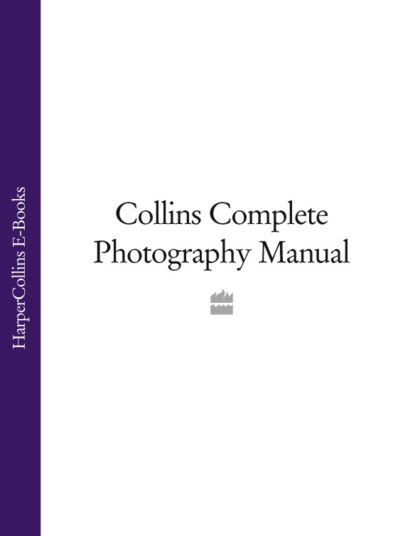По всем вопросам обращайтесь на: info@litportal.ru
(©) 2003-2024.
✖
Collins Complete Photography Manual
Автор
Год написания книги
2018
Настройки чтения
Размер шрифта
Высота строк
Поля
The first permanent photograph was produced way back in 1826 by the French inventor Nicéphore Niépce – and incredibly it involved an eight-hour long exposure! From this starting point, for all of the 19th and for most of the 20th century, taking photographs was a chemical process. Light-sensitive materials were exposed to light, developed in a darkroom, enlarged to the size required, and then fixed so that the image was permanent and would not fade. Since then the equipment and processes used have become ever more sophisticated – but the principles have basically remained the same.
The rise of digital photography
Over the last decade, however, we have witnessed a fundamental change in how we take pictures. ‘Wet’, chemical photographic processes have been replaced by ‘dry’, digital processes, revolutionizing every aspect of photography. The processes pioneered by Niépce and Daguerre have been dramatically superseded.
THE SONY MAVICA
Sony announced its Mavica digital camera in August 1981, but it was not until the late 1990s that production models were available in the shops. Technically the first Mavica was not a digital camera but a video camera, from which freeze-frame images were taken. Later models recorded onto floppy disks and then CDs, which made them extremely popular.
You might be surprised to learn that the first digital camera, the Sony Mavica, was announced as long ago as 1981, but it was not until 1990, when Kodak unveiled the DCS 100, that digital cameras became commercially available. Initially sales were slow, because the prices of digital equipment were high and the quality of output was low. However, as prices have tumbled and quality has improved, sales of digital cameras have sky-rocketed. These days not many people buy cameras that use film – sadly they have gone the way of the slide rule, the Betamax video recorder and the vinyl record. Digital is now the norm. In fact, some leading manufacturers have completely discontinued film models, and are focusing exclusively on digital.
So, when you first get started in photography, it makes sense to buy and use digital equipment, for all the reasons we gave in our introduction: economy, quality and immediacy.
Digital Compact Cameras
Digital compact cameras are small, portable and inexpensive. They are easy to use for beginners as well as being ideal ‘go anywhere’ cameras for more experienced photographers.
Megapixel ratings
The ‘megapixel’ rating typically found on digital compacts is a rough guide to the picture quality you can expect, although this is not as important now as it was when digital imaging technology was first emerging. This is because these days digital photography has advanced so much that just about any camera will take a reasonable image, regardless of the number of megapixels that it advertises. Five megapixels will give you excellent 6″ × 4″ prints and good enlargements up t0 7″ × 5″ or even 10″ × 8″. If you regularly want to print at larger sizes, go for a higher-resolution camera with 7-10 megapixels.
Zoom ranges
How long a zoom range do you want? Basic digital cameras usually have a ‘3x’ zoom range. In other words, this means that at the maximum telephoto setting you get a 3x magnification compared to the wide-angle setting. If you want to shoot subjects which are further away, you need a longer zoom range. Some compact cameras have zoom ranges up to 6x, but if you want more (10x or 12x), you should look for a ‘superzoom’ camera, though these are generally bulkier.
Tips for basic usage
Most compact digital cameras are designed for simple snapshot operation, and control the shutter speed and aperture automatically. If you want to control these manually, you will need to look for cameras with ‘PASM’ (Program AE, Aperture-priority, Shutter-priority and Manual) modes.
Checkthe battery life of your compact. Some cameras may take as few as 100-150 shots on a single charge, which is not always enough for a full day’s shooting. Aim for a battery life of 200 shots or more.
Once you have acquired your digital camera, there are a couple of tips you can use in order to take better shots.
Firstly, use the LCD to compose shots when you can, rather than the camera’s optical viewfinder(if it has one). Optical viewfinders are good in bright light, when the LCD can become hard to see, but they do not give an accurate indication of the precise area that the camera will photograph.
Shutter lag
You will also notice that compact digital cameras suffer from ‘shutter lag’, in which case you press the shutter release, but the shutter does not fire straight away. When shutter lag occurs it will typically take the camera around half a second to focus first and this can make it difficult to time your shots accurately.
To get around the problem, line up your shot first and then half-press the shutter button. The camera will focus and the focus will remain ‘locked’while the button remains half-pressed. Now wait for exactly the right moment to take the shot, then press the button the rest of the way until it is fully depressed. The shot will betaken instantly, without any shutter lag.
Digital SLR Cameras
Digital SLRs are bulkier and more expensive than compact digital cameras, but they have larger sensors which give better picture quality and more advanced photographic controls.
What is an SLR?
The acronym SLR stands for ‘Single Lens Reflex’. When you use an SLR, the picture is composed and taken through the camera’s single lens. ‘Reflex’ refers to the mirror which is used to reflect the image up into the viewfinder until the moment the shutter is released. The mirror flips up out of the way and the image then passes to the sensor at the back of the camera.
Low-cost digital SLRs have 6-10 megapixel sensors which can yield very good results, but it is worth paying a little extra for a camera with more pixels. The difference in fine detail is visible.
Lenses, kits and accessories
You can use different lenses on a digital SLR and manufacturers sell them in ‘body-only’ form, in which case you have to buy a lens separately, or as a camera ‘kit’, when a general-purpose zoom lens is included. If you already own compatible lenses, it might make sense to buy the body on its own. However, if this is your first digital SLR, you should get a kit with a lens included. This will be much cheaper than buyingthe body and the lens separately.
Canon, Nikon, Olympus, Pentax, Samsung, Panasonic and Sony all make digital SLRs. Canon and Nikon have the widest ranges, which include professional models. It is important to understand that each maker uses its own unique lens mount. You cannot use a Canon lens on a Nikon body, or a Panasonic lens on an Olympus body. When you choose an SLR you should think about the lenses, bodies and accessories you might want in the future, and which maker has the best range.
Professional SLRs
There may appear to be little difference in features between an inexpensive SLR and a more expensive professional model, but you will find that professional SLRs are much more solidly-built, will last longer and will withstand rougher handling. They are quicker to use and adjust once you have gained some experience, and they may offer faster continuous-shooting speeds as well, which could be important for wildlife or sports photography.
The benefits of SLRs
Digital SLRs are as easy to use as compact digital cameras. All have ‘point-and-shoot’ fully automatic modes, so beginners can explore the more advanced options at their own pace.
Having said that, it maybe necessary to modify your shootingtechnique a little if you are used to a compact digital camera. This is because digital SLRs have much less depth-of-field (near-to-far sharpness) than compacts, so when you graduate to an SLR you will need to get to grips with lens apertures and how these affect depth-of-field.
Finally, because the pictures are sharper than those from compacts (and digital SLR users will be expecting more from their photos anyway) it is a good idea to invest in a tripod to help avoid camera-shake in low light and to aid careful composition whenever time and space permit.
Digital SLR Cameras
Digital SLRs are superior to digital compact cameras in a number of respects. The larger sensor area produces better image definition and less digital ‘noise’ (random speckling, like film grain).
Other advantages of digital SLRs
SLRs have a different viewing system, as well. With the exception of a couple of models from Olympus and Panasonic, the design of a digital SLR makes it impossible for the sensor to feed a live image to the LCD display on the back. This means that you have to compose shots using the optical viewfinder. However, the viewfinders on digital SLRs are vastly superior to those on compact cameras and show you the view through the camera lens itself. Consequently, what you see in the viewfinder is exactly what the camera will photograph.
Digital SLRs have faster focusing systems than compact cameras, despite the fact that their lenses are physically larger and heavier. There is still some shutter lag, but it is usually far less. What’s more, you can switch to manual focusing, and the size and sharpness of the viewfinder image means that you can easily see when your subject is in or out of focus.
Digital SLRs offer manual photographic controls which are frequently missing on compact digital cameras. You have control over both the shutter speed used and the lens aperture, and this is important for many creative effects. Digital compact cameras are easy to use but ultimately limiting. SLRs offer the potential to take your photography much further.
BUILDING A SYSTEM
The enduring popularity of Single-Lens Reflex cameras can be attributed to many different factors, but the most important is undoubtedly their enormous versatility. Buying an SLR gives you the beating heart of a system that can be expanded almost infinitely, to cover a virtually unlimited range of picture-taking opportunities. In fact, it is no exaggeration to say that if you can think of a picture you can probably take it with a reflex camera. However, with such a bewildering range of equipment on the market, how do you know which to buy? Mistakes can be expensive, so you really need to get it right first time. The most crucial thing is to think carefully about what kind of pictures you like to shoot, and choose your accessories accordingly. Certainly you will need at least two lenses – possibly more depending upon your interests. As well as adding aflashgun, tripod and bag, you may want some close-up accessories, an infra-red remote control orfilters. Building a photographic system is never finished. There is always something new to buy and something new to learn.
HANDLING AN SLR
Digital SLRs are much biggerand heavier than digital compact cameras, which means you cannot just slip one into a pocket or a handbag-you need to make a conscious, deliberate decision to carry one around with you, especially if you want to have the option of using more than one lens, or fitting an external flashgun. In that case, you will need to pack everything intoabag. Unless you have extremely small handsyou will find that SLRs – despite their size and weight – handle extremely well. MostSLRs have chunky handgrips that make them comfortable to use. In fact, some people find them less fiddly than compact cameras, because there is more room for your fingers.
Greater versatility
Part of this potential comes from the fact that you can use different lenses. Digital SLRs are often supplied with a ‘kit’ lens which covers a useful everyday zoom range from wide-angle to medium telephoto. However, additionally you can acquire ultra-wide-angle lenses and longer telephoto lenses in order to extend the range of subjects and conditions that you can work with.
Some camera makers offer ‘twin lens kits’. In this case, you get a general purpose zoom and a telephoto zoom. These can represent very good value.
SLR makers also supply external flashguns which can be attached to the camera’s accessory shoe and which provide more powerful and more versatile lighting than the built-in flashgun. Manufacturers’ SLR ‘systems’ include not just lenses and flashguns, but also remote controls, battery grips, underwater housings and more.
One further advantage of digital SLRs is that they enable you to shoot ‘RAW files as well as conventional JPEG images. RAW files contain the data captured by the sensor and have not been processed into images by the camera. You carry out the RAW file processing (conversion) on your computer later on. RAW files are like ‘digital negatives’ – they contain extra image data which can often be used to produce superior pictures.











